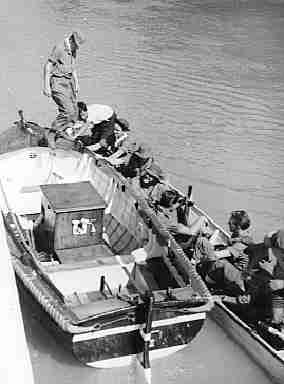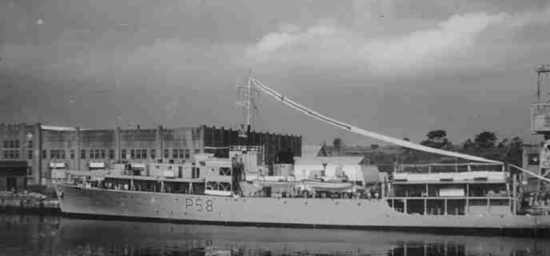- Author
- Francis, Richard
- Subjects
- Battles and operations, Post WWII
- Tags
-
- RAN Ships
- None noted.
- Publication
- September 2003 edition of the Naval Historical Review (all rights reserved)
The Inshore Flotilla of the Far East Fleet were the first ships deployed to patrol Borneo’s coastline and rivers at the outbreak of the Indonesian Confrontation in 1963.
DURING THE EARLY STAGES of Indonesian Confrontation I was serving in a humble minesweeper, HMS Woolaston, and the main scene of unrest was in Borneo, where the British colonies of Sarawak and British North Borneo were subject to raids and minor insurrection from across the border of Indonesian Kalimantan (the southern half of Borneo island). Minor units of the Far East Fleet were employed patrolling the coastline and the major rivers, mainly around the capital, Kuching, and along the long River Rajang.
One day we were patrolling the northern coast next to the border at Tanjong Datu, which was marked by a prominent lighthouse on the Sarawak side. From a mile or so offshore we could see the smoke from a small kampong near the lighthouse. Shortly after sunset the OOW observed a series of coloured signal flares being fired in the vicinity. Unaware that any military forces were in the area, we consulted our signal books and made the challenge of the day. This caused a response of a single red flare – but it was not the correct reply. The Captain and First Lieutenant consulted together and it was decided to send a small landing party ashore to investigate, while the ship remained close offshore, darkened and alert.
I was the fourth hand and most junior officer, responsible for the ship’s office, gunnery, boarding and landing party officer. We had previously carried out simple exercises before, but this was the first time the landing party had been called out in earnest. My instructions were just to investigate the incident ashore and report back via the heavy, unwieldy portable backpack VHF radio we had taken with us.

My small party of six was armed with Lanchester sub-machine guns and the radio operator carried a clumsy Smith & Wesson .38 revolver. All the seamen also wore their rigging knives on their webbing belt, which could also be a weapon of last resort. Normally I would also have carried a revolver, but had chosen to take a Very pistol instead, reasoning that if we ran into an ambush I would probably only have time to fire one shot, and I wanted that to raise the alarm as well. In my ammunition pouch I had selected three cartridges (red, green and white flares) and while on passage in the ship’s heavily loaded slow motor boat (SMB) I carefully loaded the pistol with the red flare cartridge (the cartridges were marked on the base so that one could distinguish the different colours in the dark).
We landed on a sandy beach about a hundred yards to the left of the kampong, whose cooking fires we could see and smell in the distance through the mangrove vegetation which reached right down to the beach. Leaving the most unreliable sailor as boatkeeper (and taking his weapon with us, to avoid being shot at on our return) we set out cautiously along the beach. As we approached the kampong, which seemed quite well lit by kerosene lamps as well as the cooking fires, the place appeared to be deserted. Spreading my party out for cover and support, I advanced alone with my Very pistol in my hand, through a simple barbed wire fence into the centre of the kampong. With adrenalin pumping I paused to look around and listen. “Does anyone here speak English?” I called out. There was a sickening snap of an FN rifle safety-catch being applied and a burly Royal Marine sergeant, in jungle green camouflage, stepped out from behind a large banyan tree. ‘You were bloody lucky’ he told me gruffly. ‘If you had waved that pistol around any more I would have shot you dead!’

It transpired that the RM patrol had been detailed to keep an eye on the lighthouse and any possible border crossings by Indonesian troops. They had no idea a British warship was in the area and we were equally ignorant of their mission. The flares we had seen earlier had been their recognition signal issued by GHQ in Kuching – and was totally different to the routine RN daily-changing challenge ordered by Fleet Headquarters in Singapore Naval Base. Having made a brief report on the VHF radio I withdrew my party back to the boat and we made our way, much relieved, back to the ship. I believe my little episode caused a sound overhaul of intelligence, planning and recognition throughout the Far East Fleet and GHQ deployed forces in Borneo, but it may not have passed over so easily.




